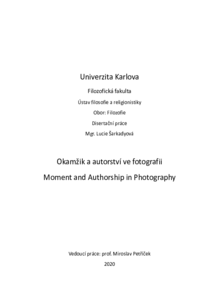Okamžik a autorství ve fotografii
Moment and Autorship in Photography
dissertation thesis (DEFENDED)

View/
Permanent link
http://hdl.handle.net/20.500.11956/117212Identifiers
Study Information System: 130908
Collections
- Kvalifikační práce [23978]
Author
Advisor
Referee
Váša, Ondřej
Silverio, Robert
Faculty / Institute
Faculty of Arts
Discipline
Philosophy
Department
Institute of Philosophy and Religious Studies
Date of defense
12. 5. 2020
Publisher
Univerzita Karlova, Filozofická fakultaLanguage
Czech
Grade
Pass
Keywords (Czech)
fotografie|fotograf|snímek|okamžik|rozhodující okamžík|zkušenost|pohyb|čas|pro-stor|život|umění|vizuální umění|fotoaparát|paměťKeywords (English)
photography|photographer|image|moment|decisive moment|experience|motion|time|space|life|art|visual art|camera|memoryVětšina prací o fotografii se zabývají obrazem a snahou porozumět fotografii jako snímku. Na rozdíl od teorie obrazu, tato práce pojednává o zkušenosti fotografa v okamžiku vzniku snímku, ale i o vlivu fotografie jako média na naše vnímání. Hlavním tématem je pak fotografie pohybu, kde můžeme nejlépe demonstrovat, jak fotografie mění jednak naše vnímání, tak rozumění vnějšímu světu. Začátek práce je věnovaný jednomu z největších českých fotografů - Josefu Sudkovi - který popisuje způsob jeho práce. Jeho vymezení fotografování, jako okamžiku "kdy do sebe všechno zapadne" a nemožnosti se už nikdy vrátit do stejného okamžiku je stěžejním rysem fotografie, tak jak je prezentovaná v této práci a základem pro tezi celé práce, která je: že fotografie a fotoaparát mění způsob vnímání a že fotografie je aktualizací možnosti toho, jak vidíme to, co vidíme. O aktualizaci možnosti je pak řeč především v kontextu díla Barbary Probst, jejíž práce "Exposures" zásadním způsobem vstupuje do historie fotografie, kdy opět důraz není kladem na obraz, ale na fotografa jako tvůrce obrazu.
Most of the work on photography is about image and trying to understand photography as an image. Contrary to this approach, this paper deals with the experience of the photographer at the time of taking the picture, and also the influence of photography, understood as a medium, on our perception. The main topic is the photography of movement, where we can best demonstrate how photography changes both our perception and our understanding of (objective) reality. The beginning of the work is devoted to one of the greatest Czech photographers, Josef Sudek, who describes the method of his work. Sudek's definition of the moment involved in taking the picture is "when everything fits together"; the impossibility of returning to the same moment is a central feature of photography as presented in this work. Consequently, the basis for the thesis is that (1) photography and camera change the way we perceive, and that (2) photography is an actualization of the possibility of how we see what we see. The actualization of the possibility is discussed mainly in the context of Barbara Probst, whose work "Exposures" fundamentally enters the history of photography, and who - once again - does not put emphasis on the image but rather on the photographer as the creator of the image.
